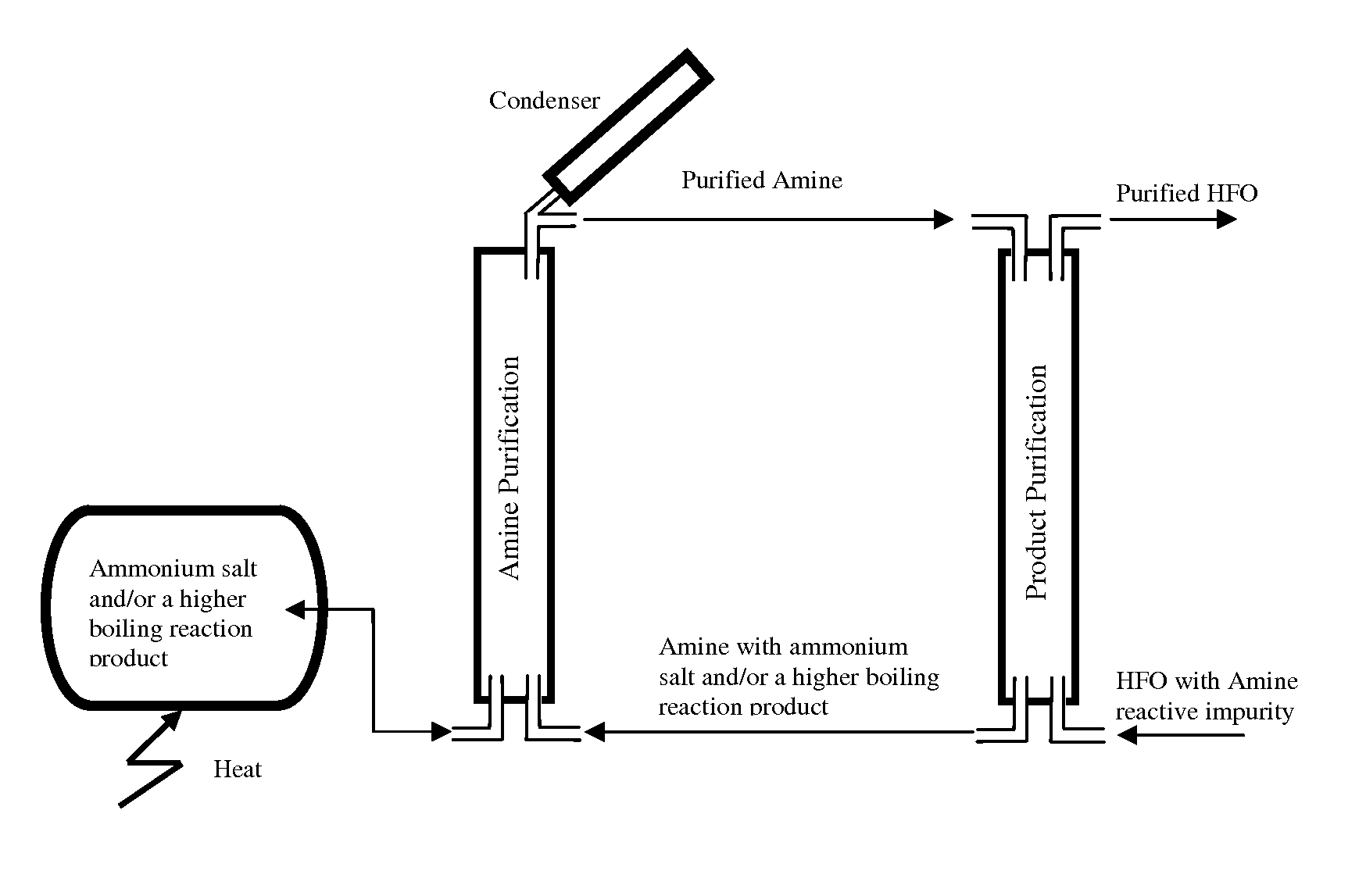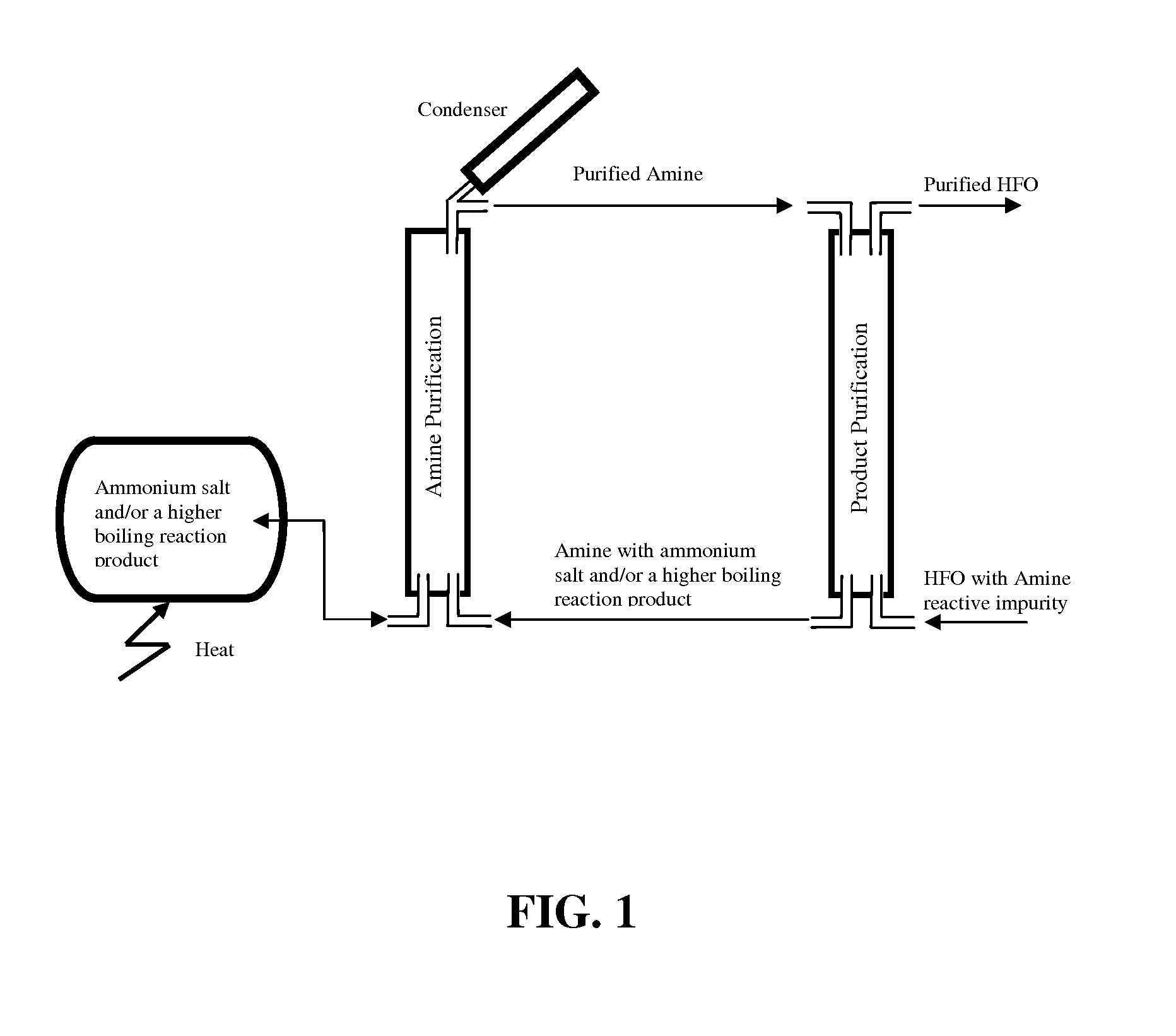Process for the purification of hydrofluoroolefins
a technology of hydrofluoroolefin and purification process, which is applied in the field of purification process of hydrofluoroolefin, can solve the problems of damage to the earth's atmosphere, use of chlorine-containing compositions, chlorine-based compounds, etc., and achieves the effect of high boiling point and without significant yield loss
- Summary
- Abstract
- Description
- Claims
- Application Information
AI Technical Summary
Benefits of technology
Problems solved by technology
Method used
Image
Examples
example 1
Relative Reactivity of HFO-1234yf and HFO-1225ye Toward an Amine
[0026]A glass pressure reactor was charged with a solution of 1.735±0.005 g of N,N,N′,N″,N″-pentamethyldiethylene triamine (Me2NCH2CH2NMeCH2CH2NMe2) in 50.0 g of a polyol based solvent. The olefin (HFO-1234yf, 3.09 g, 0.027 mol or HFO-1225ye(Z), 3.47 g, 0.026 mol) was then added and the mixture stirred with heating to 130° F. by means of an oil bath. Samples (2-3 mL) were taken periodically. The dissolved olefin in the sample was removed under vacuum and the residue analyzed for inorganic fluoride as an indication of the extent of reaction.
OlefinTime (hours)ppm FluorideHFO-1234yf19.0367.751116331HFO-1225ye(Z)20.5293646.0482771.757151
[0027]When ppm fluoride is plotted against time for each olefin, a straight line is obtained, the slopes of which show that in this test, HFO-1225ye(Z) is over 500 times more reactive than HFO-1234yf.
example 2
Removal of HFO-1225ye(Z) from HFO-1234yf Using Morpholine
[0028]A sample of HFO-1234yf which initially contained 935 ppm HFO-1225ye(Z) was bubbled through morpholine at 23° C. and ambient pressure. As the olefin exited the bubbler it was collected in a cylinder cooled by dry ice. The HFO-1225ye(Z) content of the collected material was then analyzed and again bubbled through the morpholine. The olefin was bubbled through the same sample of morpholine 4 consecutive times. A fresh morpholine sample was then placed in the bubbler and the sample was passed through for a 5th time. The results of the HFO-1225ye(Z) analysis indicate that the morpholine is able reduce the HFO-1225ye(Z) concentration by nearly ½. The electrical conductivity of the morpholine was also measured before and after the HFO-1225ye(Z) collection. The increase in the electrical conductivity indicates that a salt has formed from the olefin and morpholine. The salt can be separated from the morpholine by simple evaporati...
PUM
| Property | Measurement | Unit |
|---|---|---|
| boiling point | aaaaa | aaaaa |
| boiling point | aaaaa | aaaaa |
| concentration | aaaaa | aaaaa |
Abstract
Description
Claims
Application Information
 Login to View More
Login to View More - R&D
- Intellectual Property
- Life Sciences
- Materials
- Tech Scout
- Unparalleled Data Quality
- Higher Quality Content
- 60% Fewer Hallucinations
Browse by: Latest US Patents, China's latest patents, Technical Efficacy Thesaurus, Application Domain, Technology Topic, Popular Technical Reports.
© 2025 PatSnap. All rights reserved.Legal|Privacy policy|Modern Slavery Act Transparency Statement|Sitemap|About US| Contact US: help@patsnap.com


